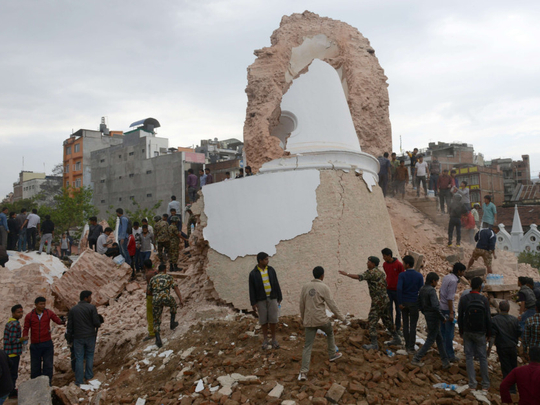
Two disasters hit Nepal at noon last Saturday. The first wiped out whole towns and villages and killed more than 6,000 people as of yesterday afternoon. With the world’s help, that disaster can be and will be rectified. The other disaster was to one of the world’s most exquisite cultural survivals, the ancient settlements of the Kathmandu valley and their Hindu and Buddhist shrines. That disaster, labelled “irreversible” by some experts, cannot be ignored. It must be rectified and without argument.
Pictures from Nepal show temples, stupas, towers and squares collapsed or severely damaged. Protected for centuries by their isolation, they have suffered the one horror from which nothing could protect them: Natural catastrophe. Irina Bokova, boss of the ever defeatist Unesco, with seven Nepalese sites on her books, says the damage is “extensive and irreversible”. The local historian Prushottam Lochan Shrestha agrees that “we have lost most of the world heritage monuments ... they cannot be restored”.
Initial surveys show appalling losses. Kathmandu’s lofty Dharahara tower is gone, taking 180 tourists with it. Durbar Square is ruined, the deity Garud toppled from its pillar. The ancient Swayambhunath Stupa outside the city stands, but in a wilderness of destruction. In Bhaktapur, the delightful Vatsala Durga temple is a pile of rubble. Boudhanath Stupa, one of the largest in the Himalayas, is damaged. Lovely Patan’s temple complex looks wrecked.
These sites and their surrounding lanes and wooden houses were among Asia’s last remaining examples of what in Europe were medieval cities, rich in shrines, palaces, markets and colour. Their tight-knit urbanism recalled the intimacy of Tudor England. They were part and parcel of Nepal’s cultural identity.
A single clearance bulldozer can wipe all trace of these places off the map. In their wake, Kathmandu can easily become another Asian concrete jungle. It was not just Second World War bombers that wiped out Europe’s old cities, it was the bulldozers and developers that came in their wake. Such vultures circle over these disasters, paid not to conserve but to relieve immediate suffering, with little care for the past or the future.
After 1945, the Germans rebuilt the Hanseatic town of Lubeck, casually flattened by the Royal Air Force to teach Germany “a lesson”. The Poles did likewise to central Warsaw, as an act of healing and defiance. Britain did not restore old Coventry or Bristol, their modernist ideologues preferring to erect new Jerusalems in the fashion of the day. As a result, Lubeck and Warsaw are now world heritage sites. No one visits England’s new Jerusalems.
Of course the first response to the Nepal earthquake must be humanitarian. But populations can and do restore themselves. The loss to a nation’s culture and identity — in Nepal’s case also to its tourist economy — can be forever. Such is the trauma of this loss that its recovery can seem unimaginable. Asia currently faces threats to its historic legacy that, were they in Europe, would be rated global cataclysms. The Mesopotamian cities of Nineveh, Nimrud and Hatra have been dynamited. Syria’s Aleppo lies in ruins. The Buddhas of Bamiyan remain gaping holes in the mountain. Western intervention in Iraq led to the looting of the great museum of Baghdad and the obliteration of some of Christianity’s oldest sites.
Most of European architecture’s great works are reproductions, from Venice’s Campanile to the turrets of Bodiam Castle
The cause in each case is irrelevant, be it war or natural disaster. The remedy is what matters. The answer to cultural destruction is restitution. There is no technical handicap. Money can always be raised, as it was after the Florence floods of 1966. The cost merely defines the value we place on that culture. The arts of conservation have never been so skilled, or scholarship so thorough. The job can be done.
One dogma stands in the way of restoring Nepal’s historic districts, the art-historical cult of the ruin. Destruction is “the historical record”, it proclaims. What war or nature has destroyed should be “conserved as found”, lest we stand condemned by the great god, authenticity. If we want to know what the past looked like, we should ask a professional consultant for an artist’s impression. All else is pastiche, “Disneyfication”.
Previous generations saw no ideological problem in restoring and if necessary reproducing the legacies of their past. Most of the great works of European architecture are reproductions, from Venice’s Campanile to the west front of Chartres, from the walls of Carcassonne to the turrets of Bodiam Castle. Kathmandu’s lofty Dharahara tower, now a pile of stones, was actually the third erected on the site after earthquakes, most recently in 1934.
Yet, the anti-restitution dogma remains influential. It has gripped 12 years of Unesco wrangling over the Bamiyan Buddhas. Some “experts” feel the holes should be left as a memorial to Taliban iconoclasm, as part of the statues’ “authentic” history. Others argue that the statues were already much restored, and the best counter to their destruction is replacing them. Asians have no aesthetic hang-ups about reproducing images of the Buddha. No one can decide.
All reminders of the past, original or replicated, are precious. The buildings and settlements in which our ancestors lived and thought, worked and prayed, are history in four dimensions. They are potent in the imagination, which is why totalitarian regimes so often seek to destroy them. Heritage sites remind people of who they are — undermining authority’s power to make them something else. That is why China is destroying Tibetan and Uighur heritage sites.
Of course the Nepalese should decide how far to go in restitution. But money, expertise and encouragement should be no bar. The placid settlements of the Kathmandu valley should return to their former glory. Likewise should Aleppo, Nineveh and Bamiyan. After the food and shelter have arrived, nothing would better lift Nepal’s pride and morale than to see its old splendour rise from the enveloping dust.
— Guardian News & Media Ltd










